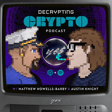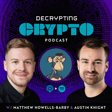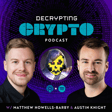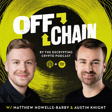Become a Creator today!Start creating today - Share your story with the world!
Start for free
00:00:00
00:00:01

Building a Bitcoin Layer 2 with Max Chamberlin of Bitfinity
In today's episode, we're joined by Max Chamberlin, the cofounder of Bitfinity - a next-gen EVM Bitcoin layer 2.
Transcript
Introduction to Bitfinity and Guest Max Chamberlain
00:00:12
Speaker
Hello and welcome to the Decrypting Crypto Podcast. I'm Matthew Housebarbie, and today we've got an exciting interview with Max Chamberlain. He is the co-founder of Bitfinity. And if you're not familiar with Bitfinity, well and you've you've been enjoying some of our recent coverage around what's being built in the wider Bitcoin ecosystem, I think this is going to be a really interesting one for you. So Bitfinity is a Bitcoin layer 2 network. um It is EVM compatible. So you can, you know, deploy like smart contracts. It's built upon and utilizes the infrastructure of ICP, which is Internet Computer Protocol, which
00:01:00
Speaker
I honestly ah known about, but really didn't know much of the details and inner workings of how it all worked, but is pretty interesting, especially in the way in which they're able to bridge native BTC um and, you know, manage the kind of cross-chain BTC wrappers, et cetera, et cetera. So there's a lot of really
Why Extend Bitcoin's Functionality?
00:01:26
Speaker
cool stuff here. And I think where Max has, An interesting perspective is, first of all, just on the need that's arose for extending the functionality of the Bitcoin blockchain and why we're going to see a you know this explosion of of layer twos, which we've talked a bit about on the podcast.
00:01:48
Speaker
so far, but they are gearing up for their their full kind of extended launch, as are you know many different Bitcoin layer 2's I think coming in later this year. But it's a cool place where you can go and play a little round, but learn exactly how Bitfinity actually works, how it interacts with Bitcoin and other chains in the future as well, maybe even potentially more. And if you're wanting to get a good grasp of what's possible with layer two on Bitcoin and even understand why they why they're even needed or valuable, this this interview is one you should definitely listen through.
Origins of Bitfinity and Bitcoin Asset Challenges
00:02:33
Speaker
All right, without further ado, let's jump straight in.
00:02:42
Speaker
Welcome to the podcast, Max. Great to have you on. We've been really down the rabbit hole in the wider Bitcoin ecosystem for quite a while now on the podcast. And ah Bitfinity has been something that obviously I've been taking a good look at and we're excited to learn a little bit more. So why don't we just kick things off with maybe you can give a little bit of a breakdown in terms of what Bitfinity is, the problem it's solving, kind of how it came about, and we'll we'll we'll go from there. yeah Well, first of all, thanks for having me on the podcast, Matt.
00:03:16
Speaker
I'm really excited to tell you a bit more about Bitfinity and um yeah because there have been a lot of exciting developments in the the Bitcoin ecosystem lately. And Bitfinity really emerged to help solve some of the challenges that we have using assets on Bitcoin. So, I mean, there's been an explosion, Cambrian explosion of ah different kinds of tokens available on Bitcoin. So we have ordinals, runes, atomicals, ah quite quite a few others. you know and I mean, there's I guess there's a long history of that. um I mean, that maybe the genesis starting with like colored coins on Bitcoin, which was sort of a precursor
Integrating Assets Across Chains
00:04:01
Speaker
to Ethereum. But um essentially, what Bitfinity does is it provides a decentralized computing environment that makes it easy to use all these different Bitcoin-based assets.
00:04:13
Speaker
on the chain. So you can think of Bitfinity as a Bitcoin layer 2 or Bitcoin EVM. um But you know our intentions are also to be a bit broader and bigger than that, ah in the sense that we want to be able to integrate cross-chain assets from lots of different chains on Bitfinity. um So that that's basically what we are in a nutshell. And I think also it's a very interesting time in Bitcoin's development. We've seen like a few projects really kick off and and take off and go exciting places, but the space is still very early and the technology and the user experience could be improved quite a bit. So yeah, we're here building.
00:04:53
Speaker
Yeah, well, i you know but certainly from my own perspective, I'm really excited about a lot of the new projects, protocols, apps that are kind of being built out to what feels like extend the ecosystem of of Bitcoin. And you mentioned there. ordinals, and we've we've seen obviously, ah despite popular consensus when they first hit the scene, have really proliferated. And it seems now with runes, we're in a similar early stage. We'll see we'll see kind of how that plays out. But why what's what's your take, Max, as someone that's building in this ecosystem right now?
Evolution and Excitement of Bitcoin Layer 2s
00:05:34
Speaker
Why do you think there's been such excitement around Bitcoin layer 2s? I feel like you know the past,
00:05:42
Speaker
nine, 12 months. I'd had bits around Bitcoin layer twos, but you know, that wasn't really a sexy term up until now, right? You know, you think lightning and really like ah what feels like a dying project. And now it's like, you know, everyone's excited about Bitcoin layer twos. What's changed? That's, I mean, that's a great question. So I think what has really changed ah First of all, i mean you know we had in the Ethereum ecosystem talk of layer 2s the idea that you could extend the the capabilities of the base layer chain without necessarily doing everything on the base layer chain. And I think that has kind of normalized the whole idea of, well, you've got another chain that is associated with um
00:06:32
Speaker
the base layer, which is still in a way connected to it. So I think Ethereum really kind of was the genesis of that. As you know, we've had we've had tokens on Bitcoin for a while, but ah with with new standards like BRC20 and ruins, we just saw a lot more dev activity going into that direction. And um I mean, if we're looking at ordinals themselves, right, they kind of have maybe a slight distinct advantage over NFT assets on Ethereum because and and but you know directly on chain, the data is on on chain, it's on the Bitcoin blockchain, right? And um and we we don't see that so much on Ethereum. You know you have it you have the asset connected um through some hash and to some off so off-chain file storage.
00:07:23
Speaker
And you know so in a way, you you had this sort of argument that, hey, you know Bitcoin has something that could conceivably be better than what Ethereum has on chain. And I think that really was the spark and and the trigger, which led to you know so much renewed activity and exploration into ruined BLC20, all these new tokens. ah But, you know, there is the obvious elephant in the room, which is Bitcoin isn't, um well, it doesn't have advanced as advanced smart contract ah scripting capabilities as Ethereum does. you So what do you do with all these assets? You've got all these interesting assets, but where is the DeFi ecosystem? And so you've had builders pouring
00:08:13
Speaker
all their energy their time their effort into creating something that actually could work on bitcoin but it the dev effort is just so high right it's you know you really have to go the extra mile to make things work in ah in a sort of decentralized way on bitcoin and i think that opened the door sort of paved the way to the conversation of well You know, we need a good DeFi environment.
Bitcoin Tokens and Meme Coin Surge
00:08:39
Speaker
So why not do it on a layer two or a side chain that is very Bitcoin focused.
00:08:46
Speaker
And so, yeah, I think that's that's why we we essentially got here. But you know if we look at um some of the trading activity as well, we could be really seeing like some of the meme coins on Bitcoin really kick off into sort of half billion dollar um you know market caps just sort of over ah a short span of a few months. And it feels like we haven't really even got into, you know, the big bull run of that. I do think we're going to see at least whether it lasts the kind of test of time or not, we'll, you know, jury me out. But I think almost certainly at least Broon's probably BRC 20 still benefits from this, right? Is that there's going to be like a meme coin bonanza that really searches on, on Bitcoin.
00:09:33
Speaker
I wanted to touch on something that you mentioned, right? Because I think when we think about runes, ordinals, and otherwise, and in particular, if we start with ordinals, because where I feel like ordinals carved out a place for itself and almost validated that, um, it it could be the leading, I guess, like primitive of ah for NFTs, is the fact that, you know, Bitcoin's block space comes with a premium, right? that and And with all of the content living directly on chain, like you say, right? You know, unlike on Ethereum, where you can actually have the content itself, you know, sitting in an AWS ah kind of server somewhere, it doesn't really matter. um Whereas like Bitcoin, you know, it's it's all on chain.
00:10:22
Speaker
How do we how do we kind of mesh that together with layer 2s on Bitcoin though? Because I guess the dichotomy like or the um the challenge there is Yeah, you know, we're maybe using like Bitcoin for whether it's like just execution or or otherwise, right? But you're still kind of doing stuff off Bitcoin and it's on a layer too. So, you know, is is this the same as kind of the ordinals and runes value prom or like what's the trade off and how do we think about whether this is
00:11:00
Speaker
You know, is it just better to just be an Ethereum layer too? Like, or, you know, what's, what's, what's the thinking on, on this?
Trade-offs and Security in Bitcoin Layer 2s
00:11:08
Speaker
Yeah, no, that's a really interesting, that's a really interesting point. um So, of course, I think you touched first on the fact that, you know, the block space is somewhat limited. So that does create a premium, right? And it means that the trading activity is always going to attract, you know, good revenues. And so that may be attractive to um marketplaces that want to deploy on on Bitcoin because, you know, with that extra premium that you have to pay to be associated with the brand and to deploy on chain on Bitcoin, you know,
00:11:42
Speaker
um there's there's always going to be that premium because of the the limited space. Whereas um we've seen this in Ethereum, there has been sort of a race to the bottom in terms of fees that marketplaces can charge. And so it's it's led to a lot of, especially in the bear market, a lot of really vicious competition, yeah which is upset the marketplaces, the creators and so forth. um So, yeah, I think, you know, that's definitely an advantage for Bitcoin, um for the on-chain market, marketplaces. And um I think, well, when it comes to, when it actually comes to, you know, how that works with layer 2s,
00:12:27
Speaker
Look, it's always going to be a trade off. We want to do things on the base chain, um but without really upgrading the capabilities because we want to see Bitcoin as digital gold. We want to see it as a secure place. And so maybe we don't want to make so many changes to the underlying infrastructure. You're going to need to have a place where you can do all kinds of complex, crazy stuff that you want to in a smart contract. If you're talking about features or marketplaces, you could have borrowing tokens to purchase more ordinals, lending against the ordinals as well, which involve all kinds of primitives, even on Ethereum, that you can't really have necessarily all on-chain. Like, for instance, oracles are pushing data off-chain on-chain.
00:13:14
Speaker
And so you need components that don't don't really um necessarily belong just on Ethereum. And so I think you know on Bitcoin, it's the same sort of trade-off. We want something that's a bit more complex, but we don't want to compromise the security of the base chain. And so you know we have to use something that is, in a way, so more disconnected. But you know I think with with the proliferation of, again, layer twos on Ethereum, the narrative has changed and people can kind of see that, hey, you know you've got these um these other compute environments that extend the capabilities and and functionality of the base chain.
00:13:56
Speaker
Yeah, and you definitely see that, right, with, you know, whether it be optimism, base, arbitrum, whatever, right? Like certainly in the Ethereum ecosystem. I don't think outside of bridging, people really care that much, right? Like I think you see it as a the wider ecosystem of of Ethereum, um which I guess kind of brings to the next kind of question, right? Which is, I feel like the biggest challenge in everything around connecting to Bitcoin and what bridging looks like. And I guess maybe if I could simplify a question to you, you know for it sounds like what i'm I'm hearing from what Bitfinity is really doing is it's
00:14:40
Speaker
more than anything, from my at least my view, you tell me if this isn't a good take on us, that you know we're kind of connecting a load of these different blockchains, these siloed ecosystems from one another, and being able to you know share liquidity across and just remove friction in going from one to to another.
Improving User Experience and Secure Bridging
00:15:00
Speaker
And if that's kind of the the the case here, what what what would a typical user experience look like? how are we What are we doing with Bitcoin? And how does like my BTC kind of start interacting outside of Bitcoin? like what What does this look like? Yep. So um we have a ah couple of different u UX flows that we're envisaging for this. um So the first is you could imagine a wallet, which is like a Bitcoin wallet.
00:15:31
Speaker
right but also has EVM capabilities through like layer 2s or sidechains. So in some sense, the bridging is embedded into the wallet itself. So when you send over your Bitcoin into the wallet, ah you're sending your Bitcoin to a Bitcoin address, but it then mints the tokens ah corresponding for the bridge tokens on the EVM. And then you can just enter into it any kind of EVM smart contract you want or interact with any kind of DAP based on an EVM.
00:16:06
Speaker
and still have it um associated with your Bitcoin wallet and you could just send out that ah the runes or the Bitcoin at the click of a button. So I think doing some innovation with how wallets work is one of the keys to really making this a unified experience that is comparable to what you see on Ethereum. And so that's that's one of the things Bitfinity is really innovating on and trying to drive ah change, win so how we how we experience and use the wallets. um I think another another interesting flow to consider as well. um So Bitfinity has this bridge widget. and um Well, I wouldn't say Bitfinity, it's an open source bridge widget. It's open source decentralized. Anyone can use it ah for anything, but ah some of the folks at Bitfinity helped with the tech on that. And essentially what you can do is um
00:17:02
Speaker
If you've got a DAP, you know you've let's say you've got a ah fork of Uniswap or a fork of Aave, you can embed this widget into your DAP and it will then allow users to just bridge over tokens. So bridge over the Bitcoin, Bitcoin-based assets into the EVM. And then you'll know exactly what but assets you you need to to have um in your DAP so that people can swap or borrow land and So I think the innovation really has to come around like the entry points into these DAPs and wallets. And doing that is gonna create like a 10 times better user experience than
00:17:45
Speaker
just bridging through some site somewhere and then trying to you know fumble your way towards the DAT and figure out exactly what's going on. So I mean, that's what we're doing at Bitfinity. So you really trying to focus, it sounds like very much on the the user experience here, just kind of removing a few of these steps, integrating kind of like the process of taking assets from one chain to another to trade like almost in ah in ah in ah in a simple flow. what What's happening in the background then when we when we think about bringing my, you said, right, you know, my BTC is stored, ah is sent to a Bitcoin address.
00:18:21
Speaker
It's bridged over, I'm assuming then we're we've got some kind of like wrapped PTC asset that's that's EVM compatible, maybe like an ERC20 token. Like what's what's the basic mechanic of of how that works? So if we're looking at the technology side, ah we leverage something called Chain Fusion, which is a threshold signature ah scheme. And this was developed by um the internet computer blockchain. So it's leveraging some of that tech to decentralize the bridging aspect.
00:18:55
Speaker
um Essentially what you can imagine is instead of just having like a Bitcoin key, private key in a server somewhere, 60% of bridge hacks, by the way, are people getting hold of the private key. yeah So instead of you know instead of having that, what you have is a threshold key, which which has been split into 50 key shares. And these are all like custodied by a single node provider on the internet computer. And these nodes come together, they form a quorum and they can sign ah Bitcoin transactions on your behalf. um so So essentially that that really helps with the security aspects because it um i mean it's been audited, vetted, um you know it's a secure protocol.
00:19:45
Speaker
that can be used, and you know it's got a very high level of decentralization as well, even compared to multi-sig approaches. The private key is never never created like anywhere, so there's no no place where the private key is stored. In some sense, it's it's just these 50 key shares. So an attacker is going to have to go in and get at least a third of these co key shares to disrupt the protocol.
00:20:13
Speaker
In addition to that, these key shares are also regenerated every, I think 10 minutes. So an attacker has a window of 10 minutes to get in, infiltrate the nodes, exfiltrate the the key shares, and then recombine them. which is a pretty difficult feat. And actually, if you look at some of the institutional custodians, Fireblocks and others, they're using similar technology, um right, to to to secure institutional assets. So it's become something of a gold standard um with custodians. And the difference is we've got the same technology here or the same kind of technology.
00:20:57
Speaker
expanded to even more nodes, so it's even way more decentralized and it's put on the blockchain. And I think that creates a really interesting and new bridging primitive ah that can secure cross-chain assets between Bitcoin and layer 2s. Nice, so and the the bridge dash that that comes with that, is that chain key Bitcoin? this Is it CK Bitcoin, BTC? that Yeah, so it's it's it's it's a variant of that, yeah. it's good Not exactly, yeah. But it's ah you could call it chain key, yeah, chain key or chain fusion Bitcoin. I see. And we have it directly bridged to the EVM.
00:21:37
Speaker
Okay. I see. All right. So then, you know, you, you're you're bridging assets kind of that way. Will it work in a similar way for things like runes? Will they kind of just almost like be wrapped in a similar way, like on an individual asset level? Yes, exactly. Yeah. So it's working the same way for runes. Um, yeah. And that, that, that creates an extra, an additional layer of security as well. Hmm.
Building on ICP for Complex Development
00:22:03
Speaker
One of the things that I that haven't quite been able to get my my head around, and i'm i' I'm looking forward to kind of understanding this a little bit, is you mentioned ICP, right the Internet Computer Protocol. um i I'll be the first to admit that I don't know a huge amount about ICP. um And I know that you've you've built a lot of the, I guess, like caught underlying technology on ICP.
00:22:32
Speaker
I guess my first question is like, why, how did that kind of come about? And I just, I don't, I haven't heard of many projects and maybe that's just my like bias of not seeing it. Like what's the, what's, what's, what's with ICP and what what's the the value add there? So yeah, there are actually quite a few Bitcoin projects um working or using some of this Chainfusion technology with i ICP. So um there's a Bionic Marketplace. So if any of your readers or viewers have heard of Bob Bodley, ah he's you know he's he's he's leading Bionic Marketplace and they've got a marketplace where you can buy ordinals.
00:23:09
Speaker
And that is using, under the hood, the same chain fusion technology that is powering Bitfinity. um So I think they've had quite a few traction and quite a lot of traction and you know thousands of trades on their platform. ah Recently, there was also a project from near from the near ecosystem called Omnity. Oh yeah. Have you heard of Omnity? I think I heard ah someone talking about that on a podcast I was listening to. I can't remember if it was like Blockworx or something like that, but i've I've heard about it. I don't know much about it. Yeah. So they're also doing like some sort of like cross chain asset transfer protocol.
00:23:47
Speaker
ah using Chainfusion. um And, you know, there are a number of others as well um ah throughout, some some focusing on, as a project, I can't remember the name, they're focusing on staking ah Bitcoin. um I had a chat with some guys at Polychain who were looking into, again, staking with Bitcoin, and they were exploring using Chainfusion as part of out of the ah part of the offering. So yeah, there's ah there's a few things that are going down. I think the best way to think about ICP is not really as a blockchain, ah you know, maybe more like a decentralized web server.
00:24:32
Speaker
And because you have a very general purpose, a very general purpose compute environment, like you can use Rust to program on ICP. And um you you have access to these primitives, like the threshold signature scheme that comes with Chainfusion. You've got access to ah HTTP outcalls, which enable you to like basically communicate with the web so the blockchain can call into the web. And yeah, this, this basically is like a really fertile ground for doing all the kind of development stuff that you can't really do on a traditional blockchain like, um, you know, Ethereum or even Solana. Yeah.
00:25:11
Speaker
Yeah, and i was I was actually going to ask, but you mentioned you could you could develop in Rust, right? this Would this pave the way to like being like compatible with Solana's virtual machine in one day? like I mean, interesting you mentioned that. like So there is an ongoing project to extend this, not just to to support. um signing things with Bitcoin, but also signing things on Solana as well. So you could you could make Solana-based transactions. the The way I think of like all this tech is like it's you know we've we've heard of Layer Zero, we've heard of Axela, which just is a bridging primitive.
00:25:47
Speaker
It's like this is basically saying, well, what if we went one layer down in the tech stack and we had access to all the tooling that makes the bridging possible? possible like What could you then do with it? So threshold signing, a better way of doing oracles through ah basically just being able to dial up any website on the blockchain. um Yeah, that's that that's what you have access to with ICP. and you know um Yeah, it's some very powerful technology. I think they have a team of about ah like ah hundred over 100 or 150 researchers at one point who are building this the technology out, including, as you might know, like Jens Groth. He was a member of the ICT team. ah one of the co One of the people who invented BLS. Oh, wow. i thinkious games Yeah, he was a part of the team. So it was a really powerful.
00:26:40
Speaker
research powerhouse and you know this is some of the stuff that's come come out of it. I feel like ICP should really be thought of as like like a layer zero kind of technology.
Bitfinity's Roadmap and Future Expectations
00:26:52
Speaker
Yeah, that's kind of the way I'm like envisioning from your the way you're describing and all of this. It feels like you know this is making it easy for to to connect to different protocols and and I guess like One of the biggest challenges I feel like we've been facing as we've been trying to, especially in the Ethereum ecosystem, scale Ethereum as being like, you know, fragmented liquidity and that being a real challenge of just, you know, having DeFi and silos and things like this.
00:27:24
Speaker
But um let's ne and I feel like we've got a good overview here. I'm i'm interested now as we kind of wrap things up, just what's what's next for Bifinity? Where are you and the team like right now in the roadmap? What's coming? ah can can Can people go on and start playing around today? Yeah. So essentially, the EVM is ready. So we have a very high performance EVM. It has about two second block times. And so, you know, you can you can get really low latency with it and it's very high throughput. I, i you know, I feel it's it's comparable to Solana and speed. So ah we've also got the Alpha versions out for the Bitcoin, the Ruins Bridge and everything, ah which is, ah you know, in an open source repo. So you can try it out.
00:28:15
Speaker
um And yeah, I think it's it's the combination of those two things that's gonna make bit Bitfinity ah one of the fastest, if not the fastest Bitcoin layer two out there. So I would definitely check it out, ah try it out, maybe deploy it, adapt if if you're interested and you know feel free to contact us. Our DMs are always open on Twitter. um you know You can reach us on through our Telegram roof as well. Awesome. Well, Max, we'll we'll make sure we share out some stuff ah in the in the show notes for how people can check out Bitfinity. I think it's bitfinity dot.network is the is the website and um we'll we'll get some stuff out on Twitter as well. But just want to say a huge thank you to come on the podcast, super interested and and excited to see when you know this this all really starts to take off and I'll be playing around myself. My pleasure, Matt. Thanks again for having me.
00:29:33
Speaker
The contents of the Decrypting Crypto podcast should not be used and are not intended as investment advice. Please do your own due diligence before making any investment, cryptocurrency or otherwise.

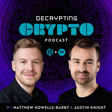
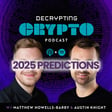
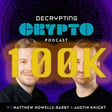
![CBDCs: The [Dark] Future of Money (Part 2 of 2) image](https://media.zencastr.com/cdn-cgi/image/width=112,quality=85/image-files/61fc0461fb20e00040aeb09e/5b9f1396-2a8e-418d-82a0-30fd00969266.jpg)

